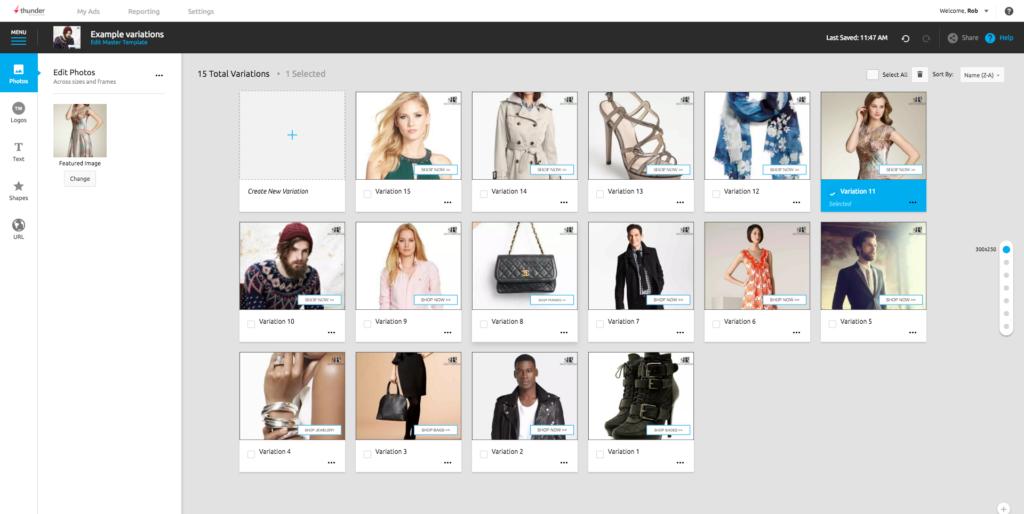
Image source: makethunder.com
Creative automation and machine learning technologies are rapidly evolving, giving birth to new marketing solutions for brands. Now, deploying personalized brand ideas at scale is not only possible, but also very easy. A common challenge among brands is to generate customized content for different audiences while maintaining brand integrity, which is where CMP's idea management platform comes into play.
CMP is short for Creative Management Platform, which integrates a range of advertising technologies into a cloud platform. The most basic CMP provides features such as creative design, scale-up tools, and integrated publishing tools. Of course, these are just the basic features. The upgraded CMP includes cross-channel publishing, campaign analysis and optimization, marketing data collection and analysis, real-time scheduling and publishing capabilities.
Brands and publishers apply CMP to produce, publish, and measure their digital creative activities. With the increasing complexity of the advertising industry, media channels and even advertising itself are becoming fragmented, and brands need to deal with a wide variety of media when publishing ideas. CMP gives control back to advertisers, reducing the complexity of the creative process through a centralized platform. On the CMP platform, all ideas are produced, distributed, and measured in a unified way.
The concepts associated with CMP are DC and DCO. DC, short for Dynamic Creative, refers to the integration of graphical elements into ad creative using specific data from shoppers such as products seen, geographic location, impression times, etc. Businesses can manually define graphical components when setting up ad impressions, and the dynamic information involved is filled in real time before each shopper provides a creative.
DCO, short for Dynamic creative optimization, is a display advertising technology. Rather than just populating general creative with personalized data, this technique uses machine learning techniques to optimize content and creativity by selecting the most relevant set of visual components to display in real time for each shopper and context.
The "dynamics" of dynamic creatives are particularly manifested in the fact that the content of the creative is based entirely on the audience's personal behavior and preferences, and if the audience stays on a product page long enough to give enough attention to the product, dynamic creative will adjust the ads that the audience sees based on these behaviors. Dynamic creatives do this through cookies, tracking data, geographic location, and recent web searches, or historical analysis of pages visited, all of which inform dynamic creative ads.
DCO combines CMP, DMP, and DSP to select the best ideas to present to your audience based on first- and third-party data sources. First, an audience that matches the target group visits the website. Start with a live auction that tracks the site's ad inventory. The DSP of an advertising campaign wins the impression with the highest bid, and it provides the advertising label for the DCO campaign. Next, the audience's browser makes a request to the DCO ad. Audience data from DMP, along with the brand's own insights, determines which dynamic content this ad shows. Then insert the recommended content into the ad. These include dynamic text fields, buttons, images, videos, and widgets, all collected and provided by CMP.
Practice Guide: Considerations for Choosing a CMP Platform
Good CMPs have unique advantages that must be taken into account when choosing the most suitable platform. Here are some of the key features that businesses should be aware of:
Digital ad creation tools: A good CMP will have a variety of built-in ad creation capabilities that simplify the design process and help brands create unique, personalized designs and impactful video content. CMP should also facilitate design in different formats, such as web ads, video content, and display ads. With CMP, creatives are hosted in the cloud and platforms, and businesses can create different messages for different groups.
Automatic code generation and high interactivity: Without CMP, creating rich and visually pleasing ads requires complex code. For design teams unfamiliar with complex encoding or HTML5, the platform offers a simple solution. The code is automatically generated according to the creative specification, which saves time over time. Simple landing page generation: The landing page is one of the most important pages in the website. Many CMPs have landing page builders, and making interactive landing pages with visually pleasing ideas will differentiate your business.
Cloud-based publishing tools: CMP is a cloud-based platform that eliminates the need to send files back and forth and constantly review content to ensure its consistency and optimization. Thanks to extensive network integration, CMP allows real-time data analysis and scheduling of active events. Achieve brand consistency across multiple channels: Creating a consistent and unified experience for users across multiple touchpoints is important to building brand value and awareness. CMP is the perfect tool to achieve this because it is a toolkit that makes it easy to generate ideas. These creatives can then be edited for different channels by clicking the button.
Dynamic creative optimization: DCO or dynamic creative optimization allows you to dynamically generate ad variations for different audiences. Based on customer behavior and other data, such as geographic location, you can use CMP to deliver the most relevant ads. Ability to upload to different channels: The ability to push ideas across different channels is key to providing users with a consistent experience. With CMP, you will be able to create a variety of digital vehicles for your marketing ideas. These include video ads, display ads, email ads, and more.
Real-time performance analytics: Digital and programmatic advertising needs to be closely monitored to optimize performance. The best CMPs include real-time analytics such as click-through rates, views, video launches, and page impressions. This allows brands to adjust ads that aren't performing well, or increase awareness of successful campaigns.